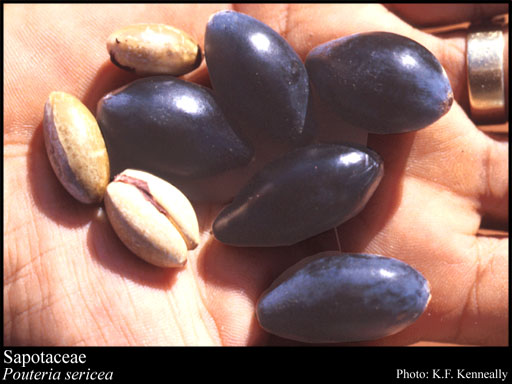- Reference
- Gen.Pl. [Jussieu] 151 (1789)
- Name Status
- Current

Scientific Description
Common name. Sapodilla Family.
Habit and leaf form. Trees and shrubs; evergreen; laticiferous. Mesophytic. Leaves alternate; spiral; leathery; petiolate; non-sheathing; simple. Leaf blades entire; pinnately veined; cross-venulate. Leaves with stipules (rarely), or without stipules. Leaf blade margins entire. Domatia recorded; represented by pits. Stem anatomy. Nodes tri-lacunar (usually), or unilacunar. Secondary thickening developing from a conventional cambial ring.
Reproductive type, pollination. Fertile flowers hermaphrodite. Unisexual flowers absent. Plants hermaphrodite.
Inflorescence and flower features. Flowers solitary, or aggregated in ‘inflorescences’; in cymes, or in panicles. The terminal inflorescence unit cymose. Inflorescences axillary (sometimes on old stems); cymose bunches. Flowers bracteolate; small (often), or medium-sized; regular (usually), or somewhat irregular to very irregular; cyclic; tetracyclic to polycyclic. Free hypanthium absent. Perianth with distinct calyx and corolla; 6–16; 2 -whorled, or 3 -whorled; isomerous. Calyx 4, or 6, or 8, or 5; 1 -whorled (then 5), or 2 -whorled (then 2+2, 3+3 or 4+4); polysepalous; when one whorled, imbricate. Corolla 3, or 4, or 8; 1 -whorled, or 2 -whorled (and sometimes ostensibly 2-whorled, through the lobes of the single whorl bearing dorsal appendages like themselves); appendiculate (with dorsal appendages on the lobes), or not appendiculate; gamopetalous; imbricate. Androecium 4–15. Androecial members adnate (to the corolla); free of one another; 1–3 -whorled. Androecium exclusively of fertile stamens to including staminodes (the outer, antesepalous whorl when present often staminodal). Staminodes 2, or 3, or 4, or 5; petaloid, or non-petaloid. Stamens 4–15; isomerous with the perianth, or diplostemonous, or triplostemonous; alternisepalous, or oppositisepalous. Anthers dehiscing via longitudinal slits; commonly extrorse; tetrasporangiate. Gynoecium (2–)4–14(–30) carpelled. The pistil (2–)4–14(–30) celled. Carpels isomerous with the perianth, or increased in number relative to the perianth (commonly double the number of one staminal whorl). Gynoecium syncarpous; eu-syncarpous; superior. Ovary plurilocular; (2–)4–14(–30) locular. Gynoecium stylate. Styles 1; attenuate from the ovary; apical. Stigmas 1; dry type; papillate; Group II type. Placentation axile, or axile to basal. Ovules 1 per locule; ascending; hemianatropous to anatropous.
Fruit and seed features. Fruit fleshy; indehiscent; a berry (the flesh sometimes sclerenchymatous near the outside). Seeds endospermic, or non-endospermic. Endosperm oily. Seeds with amyloid, or without amyloid. Embryo well differentiated. Cotyledons 2 (large, thin, flat). Embryo achlorophyllous (4/4). Seedling. Germination phanerocotylar, or cryptocotylar.
Physiology, biochemistry. Aluminium accumulation not found.
Geography, cytology, number of species. World distribution: pantropical. X = 7, 9–13. 800 species.
Economic uses, etc. Edible fruits from Achras sapota (sapodilla, sapota, marmalade plum, chiku), Chrysophyllum cainito (star-apple), Pouteria (abiu, canistel, eggfruit), Sideroxylon australe (Australian native plum).
Keys
Western Australian Genera and Families of Flowering Plants — an interactive key
T.D. Macfarlane, L. Watson, N.G. Marchant